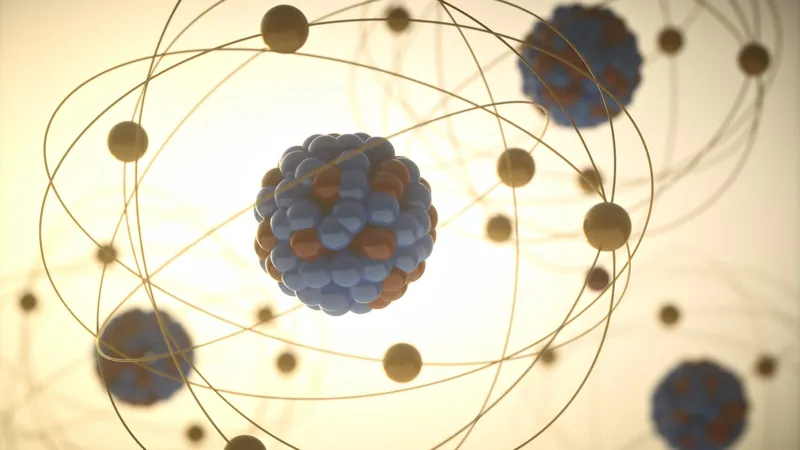
Could Mysterious 'Invisible Atoms' Unravel the Neutron Lifetime Puzzle and Dark Matter?
2025-05-31
Author: Ying
A Game-Changing Discovery in Physics!
In a groundbreaking theoretical study, scientists may have finally cracked the neutron lifetime puzzle, a conundrum that has baffled physicists for years. The key? A mysterious second flavor of hydrogen atoms that remain invisible to light—potentially holding the secrets to the universe's missing matter!
The Enigmatic Neutron Lifetime Puzzle
The neutron lifetime puzzle centers around a conflict in experimental results regarding how long free neutrons (those not bound within atomic nuclei) exist before decaying into other particles: protons, electrons, and neutrinos. Different experimental methods yield results that differ by a staggering 10 seconds, with beam experiments measuring a neutron lifetime of 888 seconds and bottle experiments measuring just 878 seconds. This discrepancy is far beyond what experimental uncertainty can explain.
The Invisible Hydrogen Hypothesis
Enter physicist Eugene Oks, whose recent study proposes that neutrons sometimes don’t decay into three particles; instead, they can decay into just a hydrogen atom and a neutrino. The twist? This hydrogen atom is electrically neutral and can slip through detectors unnoticed, producing misleading counts of neutron decays.
Oks suggests that many of these two-body decays could actually produce an unrecognized type of hydrogen atom that doesn't interact with light. This means traditional detection methods would fail, keeping these atoms shrouded in mystery.
A Closer Look at Invisible Atoms
So what distinguishes this second flavor of hydrogen? Unlike ordinary hydrogen atoms, whose electrons are generally spread out, these invisible counterparts would have electrons tightly bound to their protons, rendering them unresponsive to electromagnetic forces—which is why we can't detect them.
According to Oks, by factoring in these exotic hydrogen atoms, the decay rate could skyrocket by a factor of 3,000, enhancing their occurrence to about 1% of all neutron decays—solving the neutron lifetime discrepancy.
A Dark Matter Connection?
But there’s more at stake! Oks posits that these elusive hydrogen atoms could also shed light on dark matter, the mysterious substance thought to comprise much of the universe’s mass. In an earlier study, he linked these invisible atoms to unexpected dips in ancient hydrogen radio signals recorded by astronomers. This could mean that what we see as dark matter could actually be a more common type of baryonic dark matter made from known particles.
Testing the Theory: High Stakes Ahead!
Oks is now collaborating with experimentalists at Los Alamos National Laboratory in New Mexico to validate this theory. They plan to use electron beams to excite both flavors of hydrogen, then isolate the ordinary hydrogen atoms with lasers or electric fields, leaving only the invisible ones.
The implications are monumental—if successful, results could emerge within this year, marking a significant leap forward in both particle physics and dark matter research.
A Cosmic Revolution on the Horizon
Oks’s findings could not only resolve a long-standing puzzle but also change our understanding of cosmic history. Accurate neutron lifetimes are vital for determining the amounts of hydrogen and helium formed in the universe's infancy—so we're not just talking about tweaking theories; we’re on the verge of potentially rewriting cosmic evolution as we know it!


 Brasil (PT)
Brasil (PT)
 Canada (EN)
Canada (EN)
 Chile (ES)
Chile (ES)
 Česko (CS)
Česko (CS)
 대한민국 (KO)
대한민국 (KO)
 España (ES)
España (ES)
 France (FR)
France (FR)
 Hong Kong (EN)
Hong Kong (EN)
 Italia (IT)
Italia (IT)
 日本 (JA)
日本 (JA)
 Magyarország (HU)
Magyarország (HU)
 Norge (NO)
Norge (NO)
 Polska (PL)
Polska (PL)
 Schweiz (DE)
Schweiz (DE)
 Singapore (EN)
Singapore (EN)
 Sverige (SV)
Sverige (SV)
 Suomi (FI)
Suomi (FI)
 Türkiye (TR)
Türkiye (TR)
 الإمارات العربية المتحدة (AR)
الإمارات العربية المتحدة (AR)